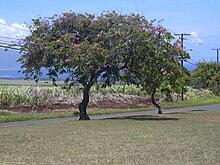Cassia javanica
| Cassia javanica | |
|---|---|
 |
|
| Scientific classification | |
| Kingdom: | Plantae |
| (unranked): | Angiosperms |
| (unranked): | Eudicots |
| (unranked): | Rosids |
| Order: | Fabales |
| Family: | Fabaceae |
| Genus: | Cassia |
| Species: | C. javanica |
| Binomial name | |
|
Cassia javanica L. |
|
| Subspecies | |
|
|
| Synonyms | |
|
|
Cassia javanica, also known as Java Cassia, Pink Shower, Apple Blossom Tree and Rainbow Shower Tree (Thai: ชัยพฤกษ์), is a species of tree in the Fabaceae family. Its origin is in Southeast Asia, but it has been extensively grown in tropical areas worldwide as a garden tree owing to its beautiful crimson and pink flower bunches.
C. javanica is one of Thailand's Nine Auspicious Trees and is said to bring good luck, ensure continued high rank and afford victory. Its flower is the provincial flower of Chainat Province, Thailand.
C. javanica is a fast growing, deciduous / semi-deciduous tree which flowers in spring and sheds its leaves in the winter months. It has a straight trunk that reaches heights of 25 - 40m. The leaves are paripinnate with 12 pairs of elliptical leaves. The flowers range in colour from pale pink to crimson with yellow coloured stamens and are found in open clusters. The ground under the tree is covered with a beautiful carpet of pink towards the end of the flowering season. The fruit are housed in long cylindrical dark brown pods. Because of its beauty and suitable size C. javanica is planted as a shade and ornamental tree on streets and in parks.C. javanica is polymorphic and several sub species such as those listed below exist.
C. javanica originated in Java and Sumatra. Native range of this species is China, Cambodia, Indonesia, Thailand, Malaysia, Myanmar, Mauritius, United States and Pacific Islands. Today it is also commonly found in other places including India and the Philippines.
In India, C. javanica flowers in April/May and fruits and sheds its leaves in December. In Thailand, C. javanica flowers between Feb and April. In East Java, C. javanica flowers between October and December and fruits in the dry season.
It is used medicinally as a substitute to Cassia Fistula for treating constipation, colic, chlorosis and urinary disorders. Its leaves are effective against herpes simplex and the bark of C. javanica is one of the ingredients in ayurvedic and other traditional medicine antidiabetic formulations.C. javanica yields a lightweight to heavy hardwood that is used for general construction, furniture and cabinet making. The bark of C. javanica is used for tanning in the leather processing industry.
...
Wikipedia
